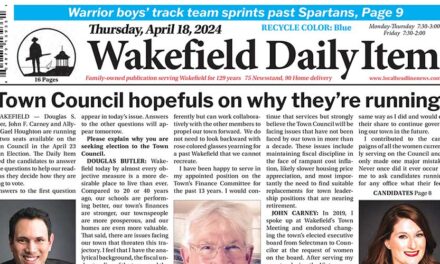Published in the July 22, 2016 edition.
By MARK SARDELLA
WAKEFIELD — Wakefield’s Public Works facilities at 27 and 29 North Ave. are some of the oldest in town and are in desperate need of rebuilding and modernization.
That was the message that DPW Director Richard Stinson conveyed to members of the Finance Committee during a 90 minute tour of the facilities yesterday afternoon. Stinson also took the group to the Nahant Street Yard Waste facility to show them the antiquated structures used for storing the salt used to treat the streets in the winter.
Stinson told the group that the Highway Department’s use of the North Avenue location pre-dates 1937. Today, he said, the North Avenue facility supports the following DPW divisions: Highway, Forestry, Parks, Fleet, Water, Sewer and a small workshop for Buildings.
In addition, Stinson noted, the North Avenue facility supports at least nine other town departments for such things as vehicle maintenance, vehicle fueling, building improvements, etc. The facility also serves as a command center for operations during snow and other emergencies.
Stinson took FinCom members on a tour of the two buildings on the site.
The older building, which he referred to a “Building 1,” was partially built before 1937, he said. A portion of it was demolished and rebuilt in 1947. Building 1 has an approximate square footage of 9,850 square feet.
The newer building (called “Building 2”) was built in 1972 and has an approximate square footage of 22,926 square feet. The total acreage of the North Avenue DPW site is 1.84 acres, Stinson said.
Stinson said that the size of the buildings and the size of the overall site are inadequate for operations. Because the ground underneath the site is contaminated, he said, the options for upgrading the current site are limited. Tearing down and rebuilding the existing facilities would require expensive environmental remediation, he noted.
Stinson began by taking the group through a tiny room used as a dispatch area. Especially during snow emergencies, he said, this room is inadequate to handle all of the DPW employees and contractors being dispatched to treat the roads.
He showed the group the vehicle maintenance shop, which is responsible for the maintenance and repair of nearly all town vehicles, including police cruisers. The shop, he said, lacked the adequate size and height to adequately work on vehicles. The low ceilings limit the height that a lift can raise a vehicle being worked on. When all of the bays and lifts are being used, Stinson said, emergency repairs often need to be put on hold until a bay can be cleared, delaying that vehicle’s return to duty.
He pointed to areas of the concrete floor near the lifts where the cement floor is cracked and sinking.
Stinson took the group through the offices of various division heads, including Parks and Forestry, the Highway Division and the Fleet Supervisor. All of the offices, he said, are inadequate for proper project review and coordination. None of the offices are large enough to hold a meeting of more than a handful of people.
Stinson showed the former paint bay, which he said is no longer used because of inadequate ventilation and environmental issues. As a result, he said, vehicles with rust and corrosion are no longer repaired. Sending them out for body work is prohibitively expensive, he said.
He took the group through Building 2, the vehicle storage garage. The building is inadequate for the storage of vehicles and equipment, he said. To accommodate all vehicles, they must be parked several layers deep, meaning multiple vehicles often have to be moved to get one vehicle out, a particular hazard in an emergency situation.
The floor drain system inside Building 2 is collapsing, Stinson pointed out. Replacing it will cost $88,000, he said.
He said that snowplow blades are stored outside, which should not be the case. He added that attaching the plows to trucks outside at night with inadequate light is dangerous and should be done in a well-lit inside area.
Stinson also pointed to Building 2 structural issues, including cracking and crumbling exterior support columns.
Other problems and deficiencies at the North Avenue facility include: serious roof leaks in both buildings; inadequate storage for parts, tools and equipment; building ventilation issues; insufficient parking for staff; structural issues with both buildings; an inadequate and outdated vehicle fueling system, and inadequate site security resulting in dumping and theft.
Stinson brought the Fincom members to the Yard Waste Facility on Nahant Street to show them the salt storage sheds located there. Those sheds are in poor condition and have environmental and safety issues, he said. They are also too small to allow the town to maximize savings. The size of the sheds also means that delivered salt must be dumped outside and then moved inside by town employees, rather than delivered directly inside using available modern technologies.
While rebuilding on the current North Avenue DPW facilities would require expensive environmental remediation, Stinson would not rule it out. He did say that any new facility built on the current site would have to be several stories and include inside parking. Any new site would have to be 4-6 acres, he said.
The vehicles, equipment and personnel at the North Avenue facility represent a substantial investment by the town, Stinson observed. But since 1972, he noted, there has been minimal funding provided for maintaining and upgrading the North Avenue Facilities.
“If we are to efficiently and economically provide the community with top-notch public works services adequate facilities are needed,” Stinson said.
“Wakefield’s Public Works facilities are in desperate need of rebuilding and modernization,” Stinson told the FinCom members, “if we are to meet the needs of the residents, business community, town departments and successfully perform our first responder duties.”




